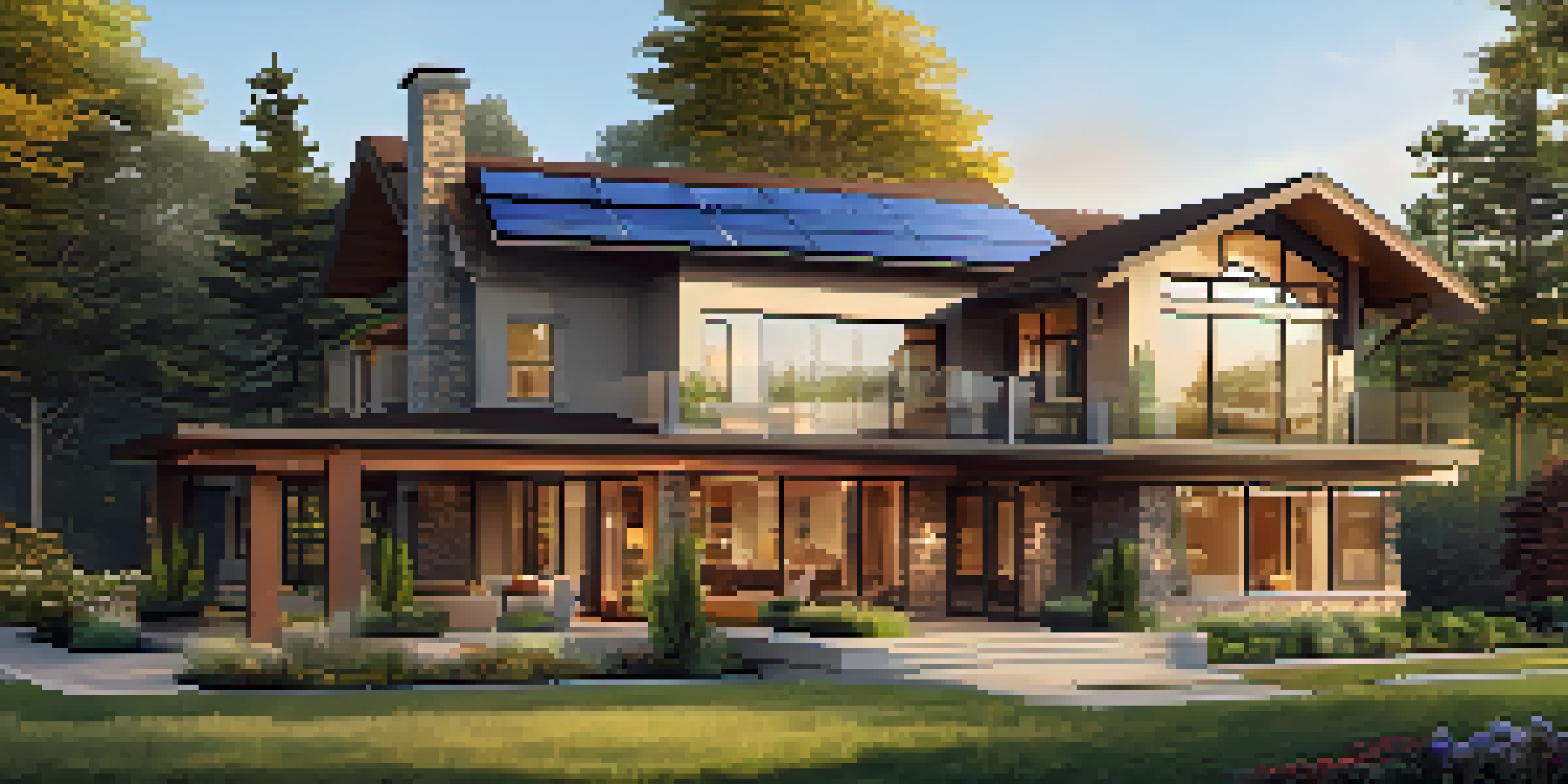Energy Star Certification for Luxury Homes

What is Energy Star Certification for Luxury Homes?
Energy Star certification is a mark of excellence for energy efficiency, applicable to various types of buildings, including luxury homes. It signifies that a home meets strict energy performance standards set by the U.S. Environmental Protection Agency (EPA). For homeowners, this means lower energy bills and a reduced carbon footprint, all while enjoying the luxurious comforts they desire.
Sustainability is not just a trend; it's a lifestyle choice that can enhance both our lives and our environment.
Luxury homes often feature high-end appliances and sophisticated systems, making energy efficiency more crucial than ever. With Energy Star certification, these homes not only boast impressive aesthetics but also demonstrate a commitment to sustainability. This dual appeal can significantly enhance the home's market value.
Obtaining Energy Star certification involves a comprehensive evaluation, ensuring that every aspect of the home—from insulation to heating systems—is optimized for energy performance. This rigorous process ensures that luxury homeowners can enjoy their space while knowing they are making a responsible choice for the environment.
Benefits of Energy Star Certification for Homeowners
One of the most attractive benefits of Energy Star certification is the potential for significant cost savings on energy bills. Certified homes use approximately 15% less energy than standard homes, which adds up to substantial savings over time. This means that luxury homeowners can enjoy their lavish amenities without the guilt of high energy costs.

Moreover, certified homes tend to have higher resale values, appealing to environmentally-conscious buyers. The growing demand for sustainable living options means that an Energy Star-certified luxury home can stand out in a competitive market. This can lead to quicker sales and potentially higher offers.
Energy Efficiency Saves Money
Energy Star certified homes use about 15% less energy, leading to significant savings on energy bills for luxury homeowners.
Additionally, Energy Star homes often come with incentives such as tax credits and rebates for energy-efficient upgrades. This financial support makes investing in energy-efficient technologies more accessible, further enhancing the allure of luxury living that prioritizes sustainability.
Key Features of Energy Star Certified Luxury Homes
Energy Star certification encompasses a wide range of energy-efficient features, which are often found in luxury homes. High-performance windows, advanced insulation, and energy-efficient HVAC systems are just a few examples. These elements work together to create a comfortable indoor environment while minimizing energy waste.
The greatest threat to our planet is the belief that someone else will save it.
Luxury homes may also incorporate Energy Star-rated appliances, such as refrigerators, dishwashers, and washing machines, that use significantly less energy than standard models. This not only contributes to lower utility bills but also aligns with the homeowner's eco-friendly values. It's a win-win situation for both comfort and sustainability.
Smart home technology is another feature that complements Energy Star certification. Home automation systems can optimize energy use by controlling lighting, heating, and cooling based on occupancy and time of day. This integration allows luxury homeowners to enjoy unparalleled convenience while ensuring their energy consumption remains efficient.
How to Achieve Energy Star Certification
Achieving Energy Star certification for a luxury home requires a multi-step process that begins with a comprehensive energy audit. This assessment identifies areas for improvement and provides a roadmap for energy-efficient upgrades. Homeowners should work with certified professionals to ensure all aspects of the home are considered.
Once necessary upgrades are made, the home must undergo a verification process to confirm compliance with Energy Star standards. This may involve inspections and testing to measure energy performance. It’s essential to choose qualified contractors who understand the certification requirements to streamline this process.
Boosts Home Value and Appeal
Luxury homes with Energy Star certification often have higher resale values, attracting environmentally-conscious buyers in a competitive market.
Finally, once the home meets all criteria, homeowners can proudly display their Energy Star certification. This not only signals their commitment to energy efficiency but also enhances the overall appeal of their luxury property, positioning it as a leader in sustainable living.
The Environmental Impact of Energy Star Homes
Energy Star certification plays a significant role in reducing greenhouse gas emissions, which is crucial in combating climate change. Luxury homes, often larger and more energy-intensive, can have a more substantial environmental footprint. By committing to energy efficiency, homeowners can help mitigate this impact while enjoying their lavish lifestyle.
In addition to reducing emissions, Energy Star homes contribute to conserving natural resources. With lower energy consumption, these homes minimize the demand for fossil fuels, leading to a more sustainable future. Homeowners can take pride in knowing their luxurious living spaces are part of the solution.
Moreover, the trend toward energy-efficient luxury living encourages manufacturers and builders to prioritize sustainable practices. As more luxury homes seek Energy Star certification, the market shifts, prompting innovations in energy-efficient technologies and materials. This ripple effect can lead to a broader transformation in the housing industry.
Real-Life Examples of Energy Star Luxury Homes
Several luxury developments across the country are leading the way in Energy Star certification, showcasing the integration of sustainability and elegance. For instance, homes in eco-friendly communities often feature cutting-edge designs that adhere to Energy Star standards while providing an upscale living experience. These homes serve as prime examples of how luxury and energy efficiency can coexist.
One notable example is a luxury estate in California that has achieved Energy Star certification through innovative design and technology. With solar panels, high-efficiency appliances, and smart home automation, this property not only stands out for its aesthetic appeal but also its commitment to environmental responsibility. Such homes inspire others to follow suit and embrace sustainable luxury.
Supports Sustainable Living
Energy Star certification helps reduce greenhouse gas emissions and encourages more sustainable practices in luxury real estate.
These success stories highlight the potential for luxury homes to lead the charge in energy efficiency. As more homeowners prioritize sustainability, the demand for Energy Star-certified luxury properties will likely continue to grow, prompting even more developments to adopt eco-friendly practices.
The Future of Energy Star Certification in Luxury Real Estate
The future of Energy Star certification looks promising, particularly in the luxury real estate market. As more consumers become aware of environmental issues, the demand for energy-efficient homes is expected to rise. This shift is likely to encourage builders and developers to prioritize Energy Star standards in their projects.
Additionally, advancements in technology will continue to enhance the efficiency of luxury homes. From smart home systems to innovative building materials, the potential for energy savings is vast. As these technologies become more mainstream, Energy Star certification will evolve to reflect new standards and practices, ensuring that luxury homes remain at the forefront of sustainability.

Ultimately, Energy Star certification represents a significant opportunity for luxury homeowners to invest in the future. By embracing energy efficiency, they not only enhance their living spaces but also contribute to a more sustainable world. This alignment of luxury living with environmental responsibility is set to shape the luxury real estate landscape for years to come.